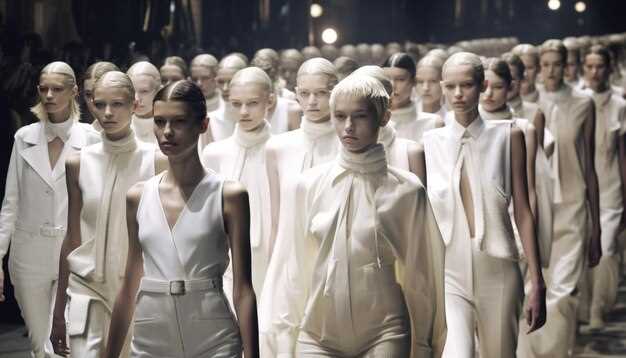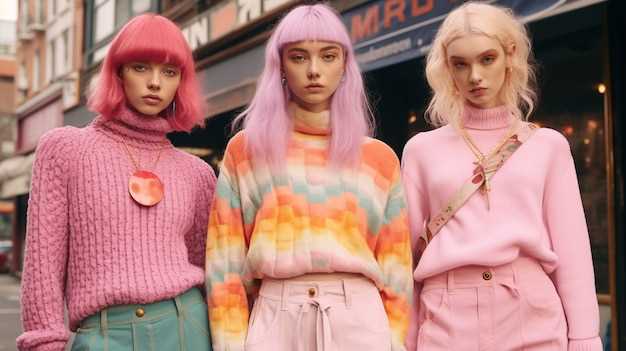
Over the course of time, the world of fashion has undergone a remarkable metamorphosis, constantly adapting and reinventing itself to reflect the ever-changing tastes and preferences of society. From one era to another, style trends have evolved, leaving an indelible mark on the cultural landscape. This journey through the annals of fashion unveils a captivating narrative of innovation, rebellion, and self-expression.
Each generation has witnessed a unique sartorial revolution, as individuals sought to define their identity and make a statement through their clothing choices. From the roaring twenties to the swinging sixties, and from the grunge-filled nineties to the sleek and minimalist aesthetic of the present day, fashion has served as a powerful medium for self-discovery and self-expression.
Throughout history, fashion trends have been influenced by a myriad of factors, including social, political, and economic changes. The rise of feminism, for instance, brought about a shift in women’s fashion, as corsets were discarded in favor of more practical and liberating garments. Similarly, the countercultural movements of the 1960s and 1970s gave birth to a wave of bohemian-inspired fashion, characterized by flowing fabrics and vibrant colors.
As fashion trends continue to evolve, they not only reflect the spirit of the times but also shape it. The power of fashion lies in its ability to transcend mere aesthetics and become a form of self-expression, a visual language that communicates our values, aspirations, and individuality. Through the decades, fashion has proven to be a powerful force, capable of uniting people, challenging norms, and inspiring creativity.
The Roaring Twenties: Flappers and Jazz Age Fashion
In the vibrant era known as the Roaring Twenties, a new wave of fashion and cultural expression emerged. This period, characterized by its exuberance and liberation, witnessed the rise of the flapper and the birth of Jazz Age fashion. The Roaring Twenties marked a significant shift in societal norms and values, as well as a departure from the traditional fashion styles of previous decades.
Flappers, young women who embraced a more independent and rebellious lifestyle, became the epitome of the Jazz Age fashion. They rejected the restrictive corsets and long hemlines of the past, opting instead for shorter, looser dresses that allowed for greater freedom of movement. The flapper style was characterized by its straight silhouette, dropped waistlines, and intricate beading or fringe details.
Jazz Age fashion also embraced a more androgynous aesthetic, with women adopting elements traditionally associated with menswear. This included wearing tailored suits, wide-legged trousers, and even cutting their hair into short bobs. The flapper look was completed with accessories such as cloche hats, long strands of pearls, and feathered headbands, adding a touch of glamour and sophistication to the ensemble.
Furthermore, the Roaring Twenties witnessed a revolution in the beauty industry, with cosmetics becoming more widely available and acceptable for women to wear. Bold red lips, smoky eyes, and heavily powdered faces were popular among flappers, who sought to challenge societal norms and express their individuality through their appearance.
The Jazz Age fashion not only revolutionized women’s clothing but also influenced men’s fashion. Men began to embrace more relaxed and casual attire, moving away from the formal and structured styles of the past. The popularity of sports such as golf and tennis also contributed to the rise of sportswear-inspired fashion, with knitted sweaters, polo shirts, and wide-brimmed hats becoming staples of men’s wardrobes.
In conclusion, the Roaring Twenties was a transformative period in fashion history, characterized by the emergence of flappers and the Jazz Age fashion. This era witnessed a departure from traditional styles, embracing a more liberated and androgynous aesthetic. The fashion choices of the time reflected the changing societal norms and values, as well as the desire for self-expression and individuality.
The Fabulous Fifties: The Rise of Dior’s New Look
In the glamorous era of the 1950s, a fashion revolution took place that would forever change the way women dressed. This era saw the emergence of a groundbreaking style known as Dior’s New Look, which brought a fresh and exciting perspective to the world of fashion. With its emphasis on femininity, elegance, and luxurious fabrics, the New Look became a symbol of post-war optimism and a departure from the practicality of wartime fashion.
A Shift in Silhouette
One of the defining features of Dior’s New Look was its dramatic shift in silhouette. Gone were the boxy and utilitarian shapes of the previous decades, replaced by a more exaggerated hourglass figure. The New Look celebrated the female form, with cinched waists, full skirts, and accentuated busts. This new silhouette was achieved through the use of corsets, petticoats, and layers of fabric, creating a sense of opulence and grandeur.
Revolutionizing Fashion
Dior’s New Look was a revolutionary departure from the austerity of wartime fashion. It represented a return to luxury and indulgence, with its lavish use of fabrics such as silk, taffeta, and organza. The New Look also reintroduced vibrant colors and intricate patterns, adding a sense of joy and celebration to women’s wardrobes. This shift in fashion not only transformed the way women dressed but also had a profound impact on society, symbolizing a newfound sense of freedom and optimism.
Furthermore, the New Look was not limited to clothing alone. It influenced hairstyles, accessories, and even the way women carried themselves. Women embraced the elegance and grace of the New Look, adopting a more refined and polished appearance. The fashion industry responded to this trend, with designers and retailers creating collections that catered to the desires of women who wanted to embrace this new style.
In conclusion, the 1950s marked a significant turning point in fashion history with the rise of Dior’s New Look. This iconic style revolutionized the way women dressed, bringing back femininity, luxury, and a sense of optimism. The impact of the New Look can still be felt today, as its influence continues to shape and inspire fashion trends.
The Swinging Sixties: Youth Rebellion and Mod Fashion
In the vibrant era of the 1960s, a wave of youthful rebellion and a distinct fashion movement known as Mod took the world by storm. This period witnessed a significant shift in societal norms and a newfound sense of freedom and expression among the younger generation. The Mod fashion movement emerged as a symbol of this rebellion, characterized by its bold and innovative style.
The Rise of Mod Fashion
Mod fashion was a direct response to the conservative and traditional fashion trends of the previous decades. It represented a breakaway from the conformity and rigidity of society, embracing a more progressive and forward-thinking approach. Mod fashion was heavily influenced by the music and subculture of the time, particularly the British rock and roll scene.
The Mod fashion movement was characterized by its sharp and clean lines, bold colors, and geometric patterns. It embraced a minimalist aesthetic, with a focus on simplicity and functionality. Mod fashion was all about making a statement and standing out from the crowd, with its distinctive style becoming synonymous with youth rebellion and nonconformity.
Key Elements of Mod Fashion

Mod fashion was defined by several key elements that set it apart from previous fashion trends. One of the most iconic features was the adoption of the mini skirt, which became a symbol of liberation and female empowerment. The mini skirt was paired with knee-high boots, creating a visually striking and daring look.
Another essential element of Mod fashion was the use of bold and vibrant colors. Mod enthusiasts embraced bright hues such as electric blue, hot pink, and sunny yellow, adding a sense of energy and excitement to their outfits. Geometric patterns, including checks and stripes, were also prevalent, adding a touch of modernity and playfulness.
Accessories played a crucial role in completing the Mod look. Oversized sunglasses, statement jewelry, and sleek handbags were popular choices, adding a touch of glamour and sophistication. The Mod fashion movement also embraced androgyny, with both men and women adopting similar styles and breaking traditional gender norms.
| Key Elements of Mod Fashion |
|---|
| Mini skirts |
| Knee-high boots |
| Bold and vibrant colors |
| Geometric patterns |
| Oversized sunglasses |
| Statement jewelry |
| Sleek handbags |
| Androgynous styles |
The Swinging Sixties marked a pivotal moment in fashion history, with the Mod fashion movement serving as a catalyst for change and self-expression. Its influence can still be seen in contemporary fashion, as it continues to inspire designers and individuals to embrace boldness, individuality, and a rebellious spirit.
The Disco Era: Glitz, Glam, and Studio 54 Fashion

The Disco Era was a time of extravagant style, vibrant energy, and a celebration of individuality. It was a period in fashion history that embraced glitz, glamor, and the iconic Studio 54 nightclub. This era was characterized by its unique blend of disco music, dance moves, and fashion trends that continue to influence modern-day styles.
The Rise of Studio 54
Studio 54, located in New York City, became the epicenter of the disco movement during the 1970s. It was a place where celebrities, artists, and fashion icons gathered to dance the night away and showcase their most daring and glamorous outfits. The club’s hedonistic atmosphere and exclusive guest list made it a symbol of the disco era and a hotspot for fashion inspiration.
Glamorous Fashion Trends
The fashion trends of the disco era were all about making a statement and embracing self-expression. Sequins, metallic fabrics, and bold colors were the go-to choices for both men and women. Disco fashion was characterized by its glamorous and flamboyant nature, with individuals often donning flashy jumpsuits, platform shoes, and wide-legged pants. Women embraced form-fitting dresses with plunging necklines and high slits, while men opted for fitted shirts and bell-bottom trousers.
| Disco Fashion Essentials | Disco Fashion No-Nos |
|---|---|
| Sequins | Baggy clothing |
| Metallic fabrics | Neutral colors |
| Platform shoes | Minimalist styles |
| Wide-legged pants | Conservative cuts |
The disco era also saw the rise of iconic accessories such as oversized sunglasses, feather boas, and statement jewelry. These accessories added an extra touch of glamour and completed the overall disco look.
Overall, the disco era was a time of bold fashion choices, where individuals embraced their individuality and expressed themselves through their clothing. The glitz, glamor, and Studio 54 fashion of this era continue to inspire and influence fashion trends today.
The Grunge Movement: Anti-Fashion and the Rise of Alternative Style
In the realm of fashion, there exists a unique and rebellious movement that emerged as a response to the mainstream trends of its time. This movement, known as grunge, defied conventional notions of style and embraced a raw and unpolished aesthetic. With its roots in the alternative music scene of the 1980s and 1990s, grunge became a symbol of nonconformity and a rejection of the fashion industry’s standards.
Unlike the carefully curated and meticulously styled looks that dominated the fashion landscape, grunge celebrated a disheveled and unkempt appearance. It embraced oversized and ill-fitting clothing, torn jeans, flannel shirts, and combat boots. The grunge style was characterized by its lack of concern for traditional beauty standards, instead prioritizing comfort and individuality.
One of the key aspects of the grunge movement was its anti-fashion sentiment. It rejected the idea of dressing to impress or conforming to societal expectations. Instead, grunge fashion was a form of self-expression and a way to rebel against the mainstream. It was a statement against the commercialization of fashion and a rejection of the idea that one needed to spend a fortune to be considered stylish.
With its rise in popularity, grunge had a significant impact on the fashion industry. Designers began incorporating elements of grunge into their collections, bringing the alternative style to the forefront of mainstream fashion. However, this commercialization of grunge also sparked debates about its authenticity and whether it had lost its original rebellious spirit.
Despite the controversies surrounding its commercialization, the grunge movement left a lasting legacy on fashion. Its influence can still be seen today in the prevalence of oversized clothing, distressed denim, and the continued popularity of alternative subcultures. The grunge movement challenged the notion of what it meant to be fashionable and paved the way for a more inclusive and diverse fashion industry.
The Digital Age: Influencers, Fast Fashion, and Sustainability
In the era of digitalization, the fashion industry has undergone significant transformations, driven by the rise of influencers, the emergence of fast fashion, and the growing importance of sustainability. This section explores the impact of these factors on the fashion landscape, highlighting their influence on consumer behavior, industry practices, and environmental concerns.
1. The Power of Influencers
- The digital age has given rise to a new breed of fashion influencers who wield immense power in shaping trends and consumer preferences.
- These influencers, through their social media platforms, have the ability to reach millions of followers and influence their purchasing decisions.
- They collaborate with brands, promote products, and create a sense of aspiration and desire among their followers.
- Their influence has disrupted traditional marketing strategies and has led to a democratization of fashion, allowing smaller brands and independent designers to gain visibility.
2. The Rise of Fast Fashion
- Fast fashion has become a dominant force in the fashion industry, fueled by the digital age and the desire for constant novelty.
- Brands like Zara, H&M, and Forever 21 have perfected the art of quickly producing affordable, trend-driven clothing.
- Fast fashion has led to a culture of disposable fashion, where garments are worn for a short period before being discarded.
- This rapid production and consumption cycle has significant environmental and social implications, including excessive waste, exploitation of labor, and the depletion of natural resources.
3. The Importance of Sustainability
- As awareness of the environmental impact of the fashion industry grows, sustainability has become a key concern for consumers and brands alike.
- Many fashion companies are now adopting sustainable practices, such as using eco-friendly materials, implementing ethical production processes, and promoting recycling and upcycling.
- Consumers are increasingly demanding transparency and accountability from brands, pushing them to embrace sustainable practices.
- The digital age has also facilitated the spread of information about sustainable fashion, empowering consumers to make more informed choices.
In conclusion, the digital age has brought about significant changes in the fashion industry, with influencers shaping trends, fast fashion dominating the market, and sustainability becoming a pressing concern. As we navigate the complexities of the digital era, it is crucial to recognize the power we hold as consumers and make conscious choices that promote a more sustainable and responsible fashion industry.
